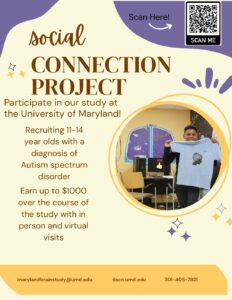Adolescent Social Connection and Loneliness Project
What's the study about?
The overarching goal of the study “Identifying biopsychosocial mechanisms predicting loneliness in typical development and autism spectrum disorder” is to investigate risk factors of loneliness in adolescents with autism utilizing behavioral assessments, functional Magnetic resonance imaging (fMRI), peer social interactions with mobile eye-tracking, and ecological momentary assessments (EMA) of social experiences and their effects on mood and loneliness.
Who can participate?
11-14-year-olds with a diagnosis of autism spectrum disorder; nothing in or on the body that would contradict participating in a magnetic resonance imaging scan; meeting research diagnostic criteria for an autism spectrum disorder which is determined via completion of the Autism Diagnostic Interview, Revised (ADI-R) with our trained staff.
What will participants be doing?
Participants’ parents will first complete the Autism Diagnostic Interview, Revised (ADI-R) virtually in order to confirm inclusion into our study. Next, participants will complete at least 2 in-person visits, which includes one visit at the Maryland Neuroimaging Center for a magnetic resonance imagine (MRI) scan. The initial in person visit includes standardized assessments of their child’s cognitive abilities and answering questions about their own experiences and interests as well as completing some computer games. Participants will then be enrolled in text messaging or ecological momentary assessment (EMA) 5 to 6 times per day for 10 days where they will be asked to report on their mood and most recent interaction. Participants will be followed over the course of 2 years; Every 4 months we will reach out to enroll them in EMA again.
Why is this important?
Each aim of the current study aims will provide a better understanding of the biopsychosocial mechanisms involved in the development of loneliness in autism that pose significant risk of negative physical and mental health outcomes. The long-term goal is to use this to inform the development of interventions to ameliorate loneliness in autistic adolescents. Identifying risk and protective factors may help inform what children are at risk for loneliness, and help develop appropriate interventions for those children.

